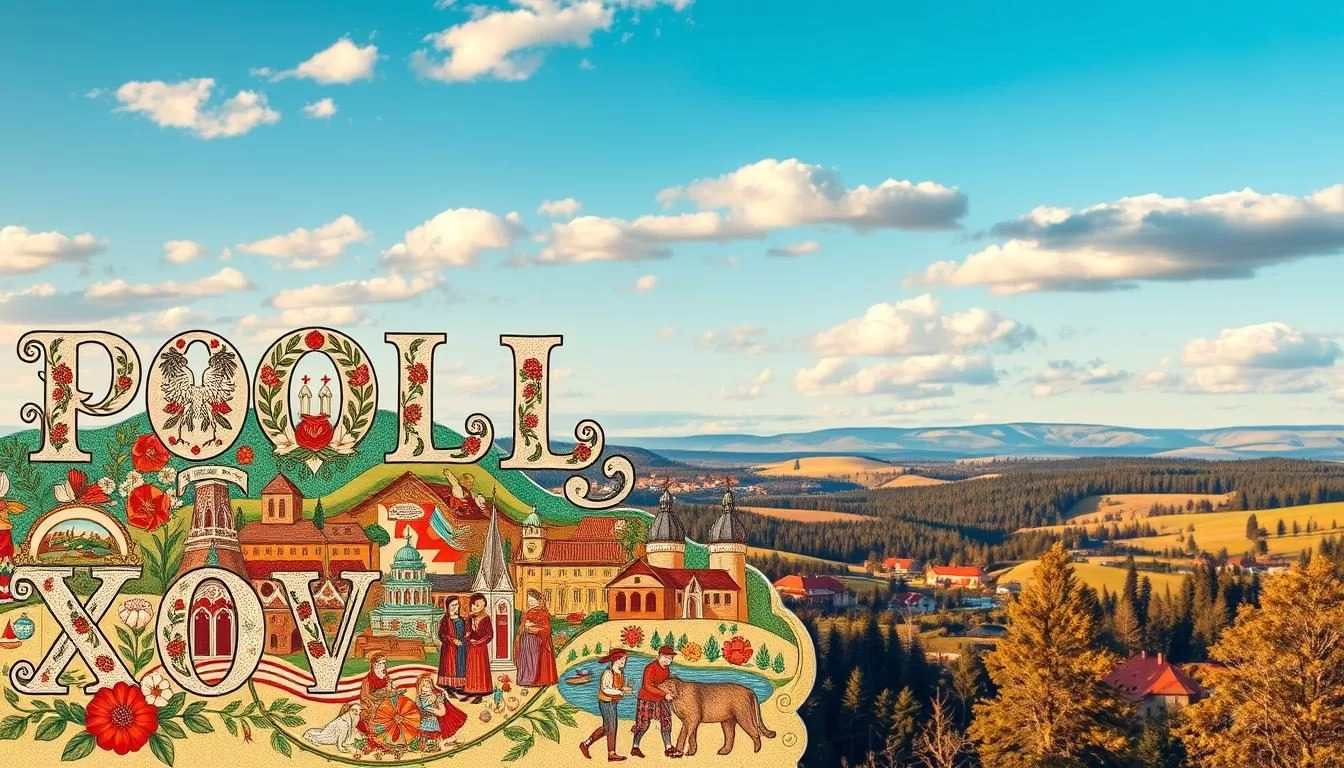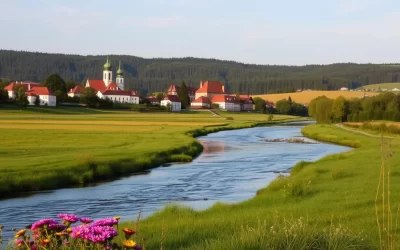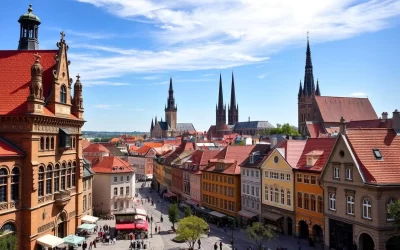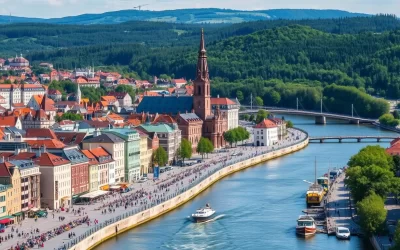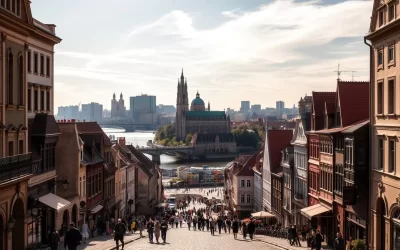Poland boasts a rich linguistic heritage shaped by centuries of history. The primary language, Polish, belongs to the West Slavic family and serves as a cornerstone of national identity. It’s spoken by the majority, with over 37 million people using it daily.
Beyond Polish, regional dialects like Silesian and Kashubian add depth to the country’s linguistic landscape. While Kashubian is spoken by a smaller community, it holds cultural significance. Foreign influences, including German and English, also play a role in shaping modern communication.
This article will explore how dialects and foreign languages contribute to Poland’s unique linguistic identity. You’ll discover fascinating insights into its cultural and historical roots. Let’s dive in!
Introduction to Poland’s Linguistic Landscape
The cultural fabric of this European nation is deeply intertwined with its linguistic heritage. For centuries, the polish language has served as a unifying force, connecting people across regions and generations. It’s more than just a means of communication—it’s a symbol of pride and resilience.
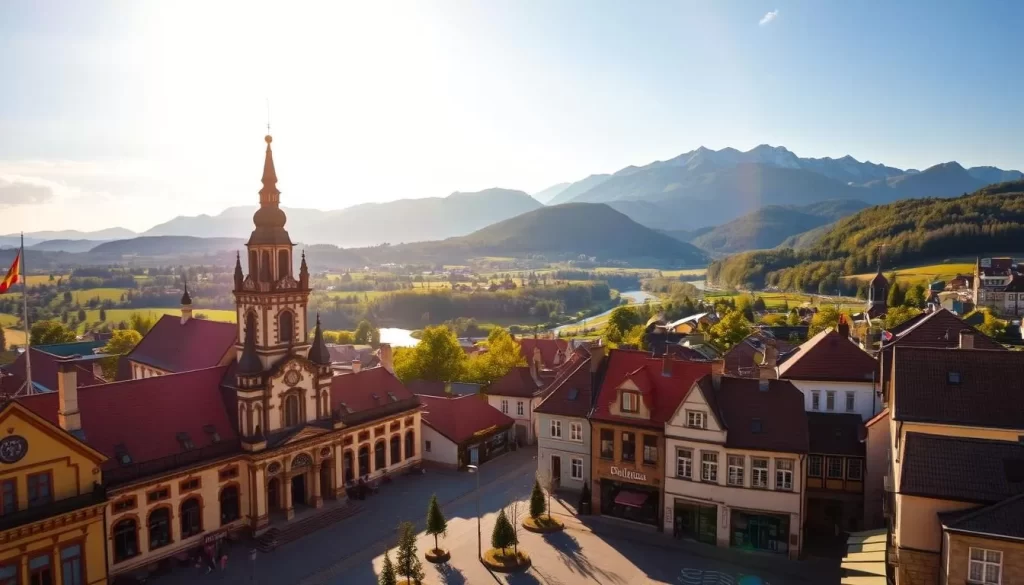
Overview of Poland’s Cultural Heritage
This country’s vibrant traditions are rooted in its diverse ethnic groups. From folk music to literature, the polish language has been a cornerstone of artistic expression. Over 97% of the population declares it as their first language, showcasing its dominance in daily life.
Historical events, such as partitions and wars, have tested the nation’s unity. Yet, the polish language remained a steadfast pillar, preserving cultural identity. Today, it continues to evolve, blending traditional elements with modern influences.
Significance of Language in National Identity
Language is more than words—it’s a reflection of values and history. In this country, it has played a crucial role in shaping national identity. From state affairs to everyday conversations, it bridges the gap between the past and the present.
Ethnic minorities, such as the Silesian community, have also contributed to the linguistic tapestry. Their dialects and traditions add depth to the cultural landscape, enriching the nation’s heritage.
As you explore further, you’ll discover how this linguistic diversity continues to thrive, shaping the identity of this remarkable country.
Poland: Official and widely spoken languages
Language plays a pivotal role in shaping the identity of this European country. Over the centuries, it has evolved into a symbol of unity and pride. Today, the linguistic landscape reflects a blend of tradition and modernity.
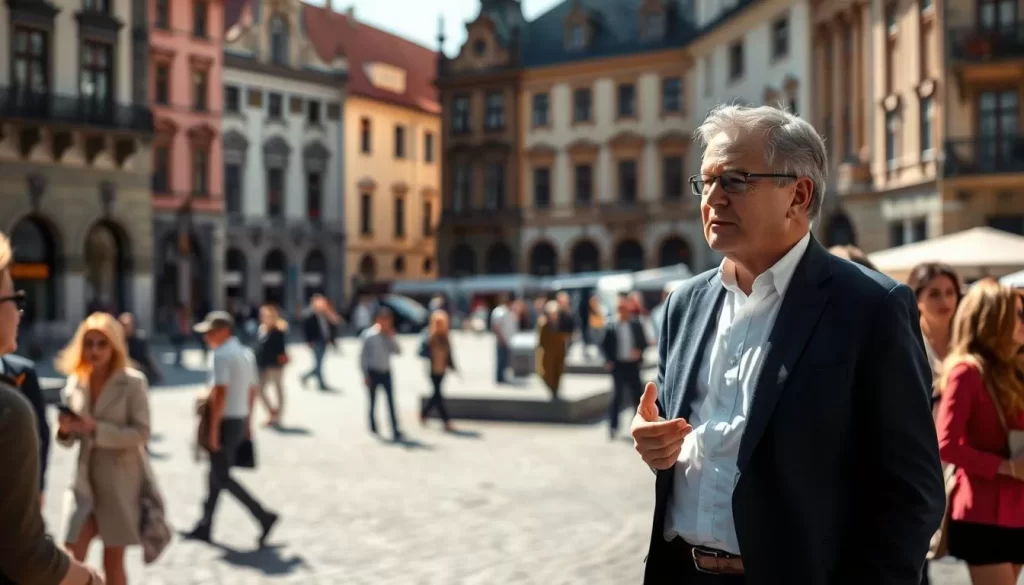
Primary Language: Polish and Its Stature
Polish is the official language, spoken by 98% of the population. It serves as the primary medium for government, education, and daily communication. With over 37 million speakers, it’s a cornerstone of national identity.
Historically, Polish became a unifying force during times of political turmoil. Its standardization in the 16th century solidified its role as a symbol of resilience. Today, it continues to evolve, blending traditional elements with modern influences.
Other Widely Spoken Languages and Communities
While Polish dominates, other languages enrich the cultural tapestry. German, Ukrainian, and Belarusian are spoken by significant communities. For example, over 96,000 people speak German, and nearly 90% of them are fluent.
Migration has also contributed to linguistic diversity. Ukrainian, spoken by over 24,000 people, is one of the fastest-growing languages due to recent immigration. Similarly, Kashubian, with 108,000 speakers, holds cultural significance in regional communities.
“Language is not just a tool for communication; it’s a bridge between cultures and generations.”
| Language | Number of Speakers |
|---|---|
| Polish | 37,815,600 |
| German | 96,000 |
| Ukrainian | 24,539 |
| Kashubian | 108,000 |
This multilingual society thrives on cultural exchange. Local dialects like Silesian coexist with the standard Polish, adding depth to the linguistic landscape. Language here is both a source of pride and a tool for cross-cultural dialogue.
Historical Evolution of the Polish Language
The Polish language has a fascinating history that spans over a thousand years, reflecting the resilience of its people. From its medieval roots to modern times, it has evolved through periods of occupation, conflict, and cultural transformation. This journey highlights how language can serve as a unifying force for families and communities.

Medieval Roots and Literary Development
Polish emerged as a distinct language in the 10th century, coinciding with the establishment of the Piast dynasty. Its early form, known as Old Polish, was heavily influenced by Latin, especially in administrative and religious contexts. The first written sentence in Polish dates back to the 13th century, marking a significant milestone in its literary history.
The 16th century is often called the Golden Age of Polish literature. During this time, the language flourished, with notable works like “The Dismissal of the Greek Envoys” by Jan Kochanowski shaping its literary tradition. The printing press played a crucial role in standardizing the language and spreading its influence across the region.
Impact of Partitions and World Wars
The partitions of the late 18th century threatened the survival of Polish as an official language. Divided among Russia, Prussia, and Austria, the language faced suppression but remained a symbol of national identity. Families and communities preserved it through oral traditions and clandestine education.
World War I brought a revival of Polish as the country regained independence. However, World War II and its aftermath led to significant changes, including border shifts and forced migrations. These events reduced the number of regional dialects but strengthened the standard form of the language.
| Period | Key Developments |
|---|---|
| 10th Century | Emergence of Old Polish |
| 16th Century | Golden Age of Polish Literature |
| 18th Century | Partitions and suppression |
| 20th Century | Revival and standardization |
Today, the Polish language stands as a testament to the resilience of its people. Its history is a reminder of how language can unite families and communities, even in the face of adversity.
Regional Dialects and Minority Languages
The linguistic diversity across regions offers a fascinating glimpse into cultural identity. From the north to the south, each area has unique dialects and minority languages that reflect its history and traditions. These variations are more than just accents—they are a testament to the resilience of local communities.
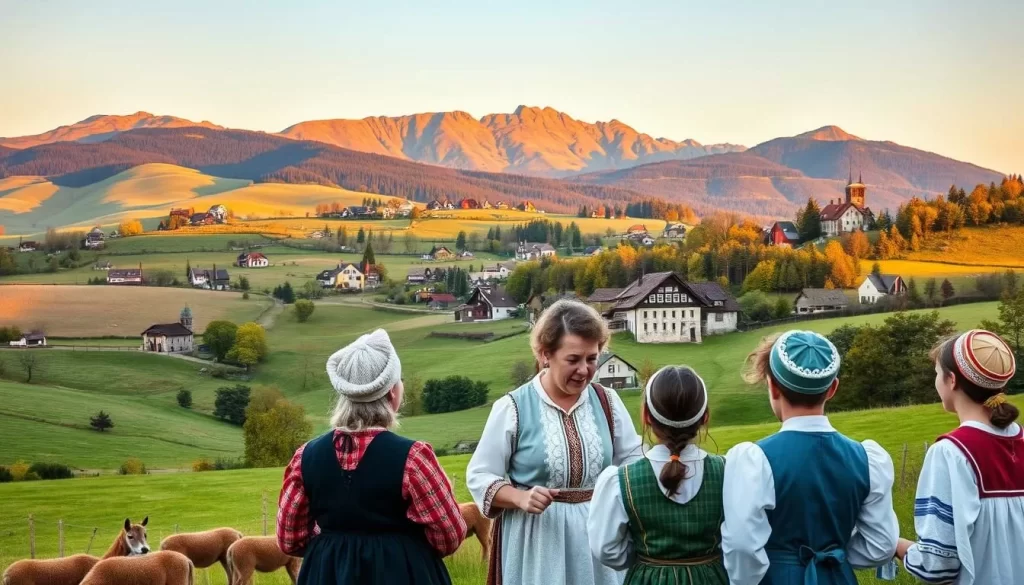
Distinctive Dialect Groups
Mazovian, Silesian, and Kashubian are among the most prominent dialect groups. Mazovian, spoken in central regions, is known for its soft pronunciation and unique vocabulary. Silesian, used in the southwest, blends elements of Polish and German, reflecting its historical ties.
Kashubian, recognized as a regional language, is spoken by over 108,000 people in the north. It holds cultural significance and is taught in schools, preserving its heritage. These dialects are not just linguistic variations—they are markers of identity and pride.
Languages of Immigrant and Minority Communities
Immigrant and minority communities have also enriched the linguistic landscape. German, Ukrainian, and Belarusian are spoken by significant groups, each contributing to the cultural tapestry. For example, over 24,000 people speak Ukrainian, a number that has grown due to recent migrations.
Government policies in the 19th century and beyond have played a role in shaping this diversity. Forced migrations and economic changes have influenced language distribution, creating a dynamic and evolving linguistic environment.
Diversification Across Northern and Eastern Territories
The north and east are particularly rich in linguistic diversity. Kashubian thrives in the north, while Belarusian and Lithuanian are spoken in the east. These languages are not just tools for communication—they are bridges to cultural heritage.
Vocabulary variations across regions highlight local history. For instance, Silesian includes words borrowed from German, reflecting centuries of cultural exchange. These linguistic features offer a window into the past and present of these communities.
Language also serves as a marker of class and identity in some contexts. In certain regions, dialects are associated with specific social groups, adding another layer to their significance. Understanding these nuances helps appreciate the depth of regional cultures.
Influences of Neighboring Cultures and Languages
The Polish language has been shaped by centuries of cultural exchange with neighboring regions. From Germanic roots to Slavic interactions, these influences have enriched its vocabulary and structure. This blend of traditions reflects the dynamic history of the region.
Germanic and Slavic Language Interactions
Germanic influences are particularly evident in regions like Silesia, where Polish and German elements blend seamlessly. Words like “rynek” (market) and “bursztyn” (amber) showcase this linguistic fusion. These interactions date back to medieval trade routes and political alliances.
Slavic roots, on the other hand, form the backbone of the language. Over 38 million people speak Polish today, making it the second-largest Slavic language after Russian. This linguistic connection fosters cultural ties across Eastern Europe.
Integration of Foreign Vocabulary Over the Centuries
Polish has absorbed words from Latin, French, and Italian, especially during the Renaissance and Enlightenment. Terms like “kultura” (culture) and “uniwersytet” (university) highlight this borrowing. These additions reflect the intellectual and artistic exchanges of the time.
The 20th century brought further changes, with global events like the World Wars influencing language use. Migration patterns introduced Ukrainian and Belarusian words, enriching the linguistic landscape. Today, these foreign elements are seamlessly integrated into everyday speech.
- Germanic Influences: Words like “szlachta” (nobility) and “król” (king) have Germanic origins.
- Latin Contributions: Legal and religious terms, such as “prawo” (law) and “kościół” (church), derive from Latin.
- Modern Adaptations: English words like “komputer” (computer) and “internet” are now part of the lexicon.
Understanding these influences helps you appreciate the depth of the Polish language. To explore more about its evolution, check out this Polish language history resource.
Language in Polish Education and Governance
Language education and governance are deeply connected in shaping cultural identity. Policies in schools and government ensure that the polish word remains a unifying force. These efforts help preserve heritage while adapting to modern needs.
State Policies on Language Standardization and Bilingual Education
State policies focus on standardizing the word to maintain consistency across regions. Over 97% of citizens declare Polish as their first language, making it essential for education and governance. Bilingual programs also play a key role, especially in areas with diverse dialect groups like Silesian and Kashubian.
For example, schools in Silesia teach both standard Polish and the local dialect. This approach helps students appreciate their heritage while mastering the national language. Bilingual education also prepares them for global opportunities, where polish english proficiency is increasingly valuable.
Role of Language in Cultural and Political Identity
Language is more than a tool for communication—it’s a symbol of unity. In political discourse, the name of policies and initiatives often reflects cultural values. For instance, programs promoting regional languages emphasize inclusivity and diversity.
Debates over preserving dialects versus standardizing language norms highlight this balance. While some argue for stricter standardization, others advocate for the protection of regional identities. These discussions shape policies that influence social and cultural development.
“Language is the foundation of a nation’s identity, bridging the past and the future.”
To learn more about the Polish language and its accessibility for learners, check out this informative resource. Understanding these policies helps you appreciate how education shapes language usage and identity.
Practical Guide to Pronunciation and Grammar
Mastering Polish pronunciation and grammar opens doors to understanding its rich cultural heritage. Whether you’re planning to visit a city or connect with native speakers, this guide will help you navigate the essentials. Let’s dive into the alphabet, phonetics, and unique grammatical features that make Polish an indo-european language worth learning.
Phonetics and the Polish Alphabet
The Polish alphabet is based on Latin letters but includes unique characters like Ą, Ć, Ę, Ł, and Ź. These letters have distinct sounds that may be challenging at first. For example, “Ł” is pronounced like the English “w,” while “Ć” has a soft “ch” sound.
Pronunciation often involves consonant clusters, such as “szcz” in “szczecin,” a major city. To master these, break them into smaller parts and practice slowly. Remember, stress in Polish words typically falls on the next-to-last syllable.
Unique Grammatical Features Explained
Polish grammar includes three genders: feminine, masculine, and neutral. Nouns change based on gender, case, and number person. For instance, the word “miasto” (city) is neutral and follows specific declension rules.
Verbs also vary by tense and number person. For example, “być” (to be) conjugates differently for “I am” (“jestem”) and “we are” (“jesteśmy”). Understanding these patterns is key to forming accurate sentences.
Resources for Learning and Practicing Polish
To enhance your skills, explore resources like Polish grammar basics and ultimate Polish language tutorial. These guides offer practical tips and exercises for beginners.
Interactive tools, such as PolishPod101.com, provide audio lessons and quizzes. Practice everyday phrases like “Dzień dobry” (Good morning) to build confidence. Today, many apps also offer pronunciation drills to help you sound like a native speaker.
| Polish Letter | Pronunciation |
|---|---|
| Ą | Nasal “o” |
| Ć | Soft “ch” |
| Ę | Nasal “e” |
| Ł | English “w” |
| Ź | Soft “zh” |
With consistent practice and the right resources, you’ll soon find yourself comfortable with Polish pronunciation and grammar. Start today and unlock the beauty of this indo-european language.
Conclusion
Exploring the linguistic landscape reveals a vibrant tapestry of culture and history. The primary language serves as a cornerstone of identity, connecting people across generations. Regional dialects and minority languages add depth to this rich heritage, showcasing the diversity within the area.
Neighboring cultures have influenced the evolution of the language, blending traditional elements with modern adaptations. Educational policies emphasize the importance of preserving this linguistic diversity, ensuring it remains a vital part of cultural expression.
For those eager to learn, mastering pronunciation and grammar opens doors to deeper connections. Practice common phrases and explore resources to enhance your skills. Language is more than communication—it’s a bridge to understanding and community.
Discover more about this fascinating topic by visiting this resource. Embrace the journey of learning and appreciate the beauty of linguistic diversity.
The above is subject to change.
Check back often to TRAVEL.COM for the latest travel tips and deals.
Here are some Tours & Sightseeing suggestions that might pique your interests!
